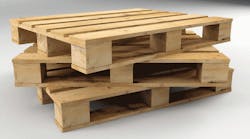Sales of new and refurbished pallets will expand 3.5 percent per year through 2017 to 1.3 billion units, valued at $16.9 billion, according to a new study from The Freedonia Group, Inc., a Cleveland-based industry market research firm. The "Pallets" report states that a more favorable economic climate will induce companies to discard aging refurbished units and purchase new ones, fueling stronger sales growth.
Whether those new pallets should be disposable or reusable depends on the nature of one's supply chain. Up to 80% of the cost of a reusable program involves managing the return of the asset over its usable life, according to Bob Klimko, director of marketing-retail supply chain for ORBIS Corporation, makers of plastic pallets. But pallet vendors are making tools available to help manage those costs.
"Web apps can give visual identification to where products are at different nodes in the supply chain," he says. "With RFID you can be more exact. For a bakery we took about 10-15% of their assets in four of their bakeries and tracked them in and out of those facilities. We were able to identify where the losses occurred and they could focus via exception management to attack those areas."
Tracking can take a range of forms: a standalone system that's not integrated with a company's order system can be a debit/credit setup on a spreadsheet; then there's a semi-integrated system that can introduce limited integration with an order system via scanned input of container information; finally, there's full integration which is seamless meshing of container and order information (when an order is shipped or received the associated container information is transmitted or captured at the same time).
Klimko identifies a four-step process for adopting a returnables program:
• Awareness
• Acceptance (getting stakeholder alignment)
• Implementation (establishing how jobs will change as a result
• Refinement (improvements, such as going from a standalone system to integration with an order system).
On the wood side, Freedonia states that block pallets will make up a larger share of the market total, and growing numbers of manufacturers will replace their existing stringer pallets with new block units.
Although wood pallets are by far the most commonly used type, metal and plastic pallets, are expected to register more impressive sales gains, according to Freedonia. Through 2017, sales of metal pallets will advance rapidly from the low 2012 market base as idle stocks are eliminated and new units are purchased to bring the number of these pallets available for use to required levels.
Plastic pallets will continue to record above average demand increases, Freedonia concludes. Plastic pallets last for many years and are fully recyclable, allowing producers to tout both their lower lifecycle costs and environmental friendliness—as long as they can be recovered and managed.
| % Annual Growth | |||||
| Item | 2007 | 2012 | 2017 | 2007-2012 | 2012-2017 |
| Pallet Demand | 1198.0 | 11.35.0 | 1345.0 | -1.1 | 3.5 |
| Wood | 1129.0 | 1065.0 | 1255.0 | -1.2 | 3.3 |
| Plastic | 23.1 | 25.8 | 37.0 | 2.2 | 7.5 |
| Metal | 7.8 | 5.5 | 9.0 | -6.7 | 10.4 |
| Corrugated Paper | 38.1 | 38.7 | 44.0 | 0.3 | 2.6 |
Of course a case can be made for using both expendables and reusables. That case depends on tracking costs as well as the assets themselves. Craig Carson, CEO of Jeco Plastic Products, makers of specialty pallets, notes that the capital loss each year in non-recovered pallets is "astonishing."
"You're talking about a loss ratio in a year that's quite significant—somewhere between 10-20%, and some admit that it's higher," he says. "If you're losing 25% of your capital base each year, the cost becomes prohibitive."
Carson admits that although his company makes plastic pallets, they usually ship on wood.



